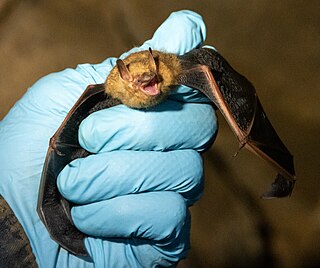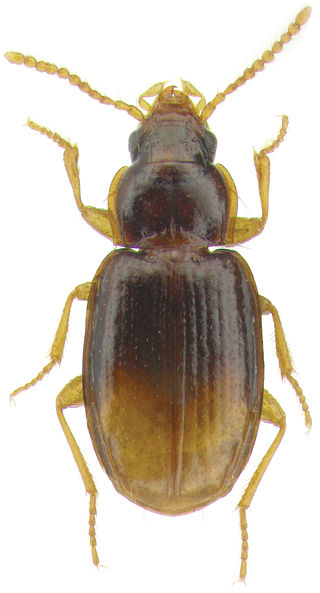
The New World leaf-nosed bats (Phyllostomidae) are bats found from southern North America to South America, specifically from the Southwest United States to northern Argentina. They are ecologically the most varied and diverse family within the order Chiroptera. Most species are insectivorous, but the phyllostomid bats include within their number true predatory species and frugivores. For example, the spectral bat, the largest bat in the Americas, eats vertebrate prey, including small, dove-sized birds. Members of this family have evolved to use food groups such as fruit, nectar, pollen, insects, frogs, other bats, and small vertebrates, and in the case of the vampire bats, even blood.

Desmodus is a genus of bats which—along with the genera Diaemus and Diphylla—are allied as the subfamily Desmodontinae, the carnivorous, blood-consuming vampire bats of the New World leaf-nosed bat family Phyllostomidae.

The tricolored bat or American perimyotis is a species of microbat native to eastern North America. Formerly known as the eastern pipistrelle, based on the incorrect belief that it was closely related to European Pipistrellus species, the closest known relative of the tricolored bat is now recognized as the canyon bat. Its common name "tricolored bat" derives from the coloration of the hairs on its back, which have three distinct color bands. It is the smallest bat species in the eastern and midwestern US, with individuals weighing only 4.6–7.9 g (0.16–0.28 oz). This species mates in the fall before hibernation, though due to sperm storage, females do not become pregnant until the spring. Young are born helpless, though rapidly develop, flying and foraging for themselves by four weeks old. It has a relatively long lifespan, and can live nearly fifteen years.

The common vampire bat is a small, leaf-nosed bat native to the Americas. It is one of three extant species of vampire bats, the other two being the hairy-legged and the white-winged vampire bats.

Chalinolobus tuberculatus, known more commonly as the New Zealand long-tailed bat, the long-tailed wattle bat or pekapeka tou-roa, is a small insectivorous mammal within the genus Chalinolobus. The long-tailed bat is one of 7 species belonging to the genus Chalinolobus, which are commonly referred to as “wattled bats,” “pied bats” and “long-tailed bats." The genus Chalinolobus is characterised by fleshy lobes located on their lower lips and at the bottom of their ears. Some zoologists claim there is overlap between the Chalinolobus genus and the Glauconycteris genus.

Eptesicus is a genus of bats, commonly called house bats or serotine bats, in the family Vespertilionidae. The genus name is likely derived from the Greek words ptetikos 'able to fly' or petomai 'house flier', although this is not certain.

Genoways's yellow bat is a species of vesper bat found only in Mexico. It is threatened by habitat loss. Due to its imperiled status, it is identified by the Alliance for Zero Extinction as a species in danger of imminent extinction.
The Ethiopian long-eared bat or Ethiopian big-eared bat is a species of long-eared bat in the family Vespertilionidae.

Vampyressa is a genus of bats in the family Phyllostomidae, the leaf-nosed bats. They are known commonly as the yellow-eared bats or yellow-eared vampire bats.
The Mindoro stripe-faced fruit bat, nicknamed the "flying fox" for its foxlike face, is a species of large megabat that is endemic to the island of Mindoro. The Mindoro stripe-faced fruit bat ranked sixth in the top ten species of 2008, selected by the International Institute for Species Exploration.

Laephotis is a genus of bats in the family Vespertilionidae. Species within this genus are:
Liodaptus is a genus in the ground beetle family Carabidae. There are at least two described species in Liodaptus, found in south and southeast Asia.

Pelmatellus is a genus of ground beetles in the family Carabidae. There are at least 20 described species in Pelmatellus.
Polychaetus is a genus in the ground beetle family Carabidae. There are at least two described species in Polychaetus.
Catapiesis is a genus in the ground beetle family Carabidae. There are about eight described species in Catapiesis, found in Mexico, Central America, and South America.

Setalidius is a genus in the ground beetle family Carabidae. There are at least two described species in Setalidius, found in New Caledonia.
Erwiniana is a genus in the ground beetle family Carabidae. There are more than 50 described species in Erwiniana, found in Central and South America.

Mioptachys is a genus of beetles in the family Carabidae, containing the following species:

Mexitrechus is a genus in the ground beetle family Carabidae. There are about six described species in Mexitrechus, found in Mexico.

Anthribola is a genus in the longhorn beetle family Cerambycidae. There are about 11 described species in Anthribola, found in Madagascar.














